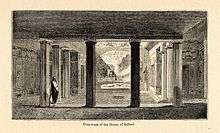House of Sallust

The House of Sallust is a domus or elite residence in the ancient Roman city of Pompeii. The oldest parts of the house have been dated to the 4th century BC, but the main expansions were built in the 2nd century BC. The long history of this structure provides important evidence about the development of elite residences in Pompeii. The house is located on the east side of the Via Consolare. It received its modern name from an election notice placed on the facade, recommending Gaius Sallustius for office. An alternative name is the House of A. Cossus Libanus, from a seal found in the ruins.
It was first excavated between 1805 and 1809, was damaged by a bomb in World War II, and was restored in 1970.
History
The House of Sallust was originally a single atrium house from the Samnite Period, and was made of Tufa blocks. It had six shops on its west side and an entrance corridor in the middle. This went though into the atrium with compluvium and impluvium. The atrium contained two alae, four cubicula, a tablinum, four other rooms and a garden. [1]
Over time, we can see the addition of new features, such as the peristyle (a colonnaded garden) which was imported from Greece in the 2nd century BC, and the second atrium, which also became popular around this time. It eventually expanded to use almost all the garden space, but its development was cut short due to the eruption of Mount Vesuvius.
See also
Notes
- ↑ Pompeii and the domestic garden
References
- Thorpe, Martin, (1995), Roman Architecture: Classical World Series, Bristol Classical Press, ISBN 1-85399-421-9, ISBN 978-1-85399-421-0
Coordinates: 40°45′04″N 14°28′57″E / 40.7512°N 14.4826°E